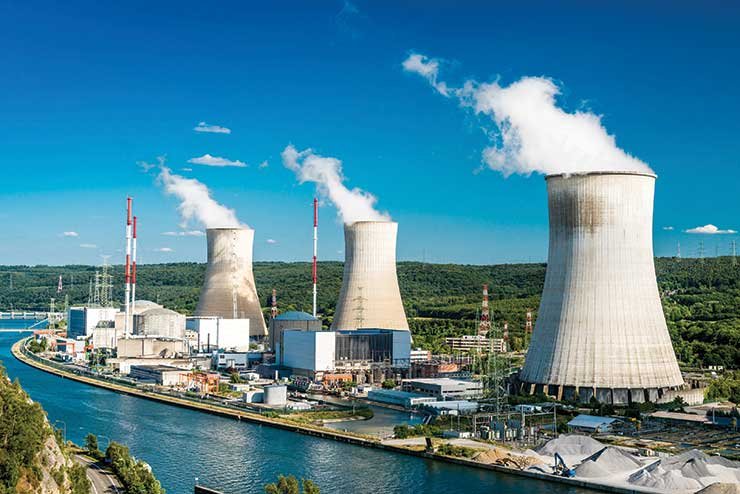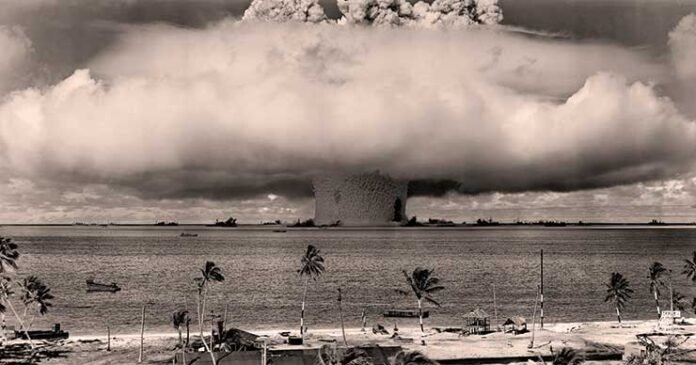The advent of nuclear weapons as the penultimate military deterrence against an adversary is almost seven decades old. The only known historical but catastrophic military use of these weapons has been in Hiroshima and Nagasaki. Their effects are being endured by the Japanese even to this day. Thus, the aftermath of their devastating consequences of immediate destruction at ground zero and the long-term generational impact on genetic mutation, spread across several generations, forbids the recurrence. Yet they form an important constituent of military arsenal that is brandished as a measure of their overarching edifice of deterrence buttressing conventional superiority amongst nuclear nations. As of September 2024, there are nine countries with nuclear weapons. Russia leads the pack with 45.4 per cent of the global total followed by the United States with 42 per cent. The rest namely China (4.1 per cent), France (2.4 per cent), the UK (1.8 per cent), India (1.4 per cent), Pakistan (1.3 per cent), Israel (0.7 per cent), and North Korea (0.2 per cent) constitute the balance.
Nuclear Deterrence
Nuclear deterrence has played its card effectively both in terms of active as well as passive deterrence. Conflicts between India and Pakistan are a classic example of active deterrence where there have been several hot war engagements under a nuclear backdrop. Whereas the belligerence between the US and Russia, the US and China, or India and China strictly borders on passive deterrence aimed at war prevention. Therefore, the run-up to this objective focuses on stockpiling nuclear warheads and deliverance mechanisms. Russia and the US are far ahead in this game whereas China is sinking large sums to achieve parity. That notwithstanding, China’s strategic alliance with Russia is a strong counter to the US in the near term. This purports to display the inter-se superiority of a linear continuum whose actual effect is hard to predict.
This weapon has been brandished recently as a threat beyond its deterrence effect to negate force asymmetry. North Korea vis-a-vis the US and the more recent Russia-Ukraine conflict where NATO has been kept out of the conflict calculus are cases in which the nuclear arsenal is playing a significant countervailing role in preventing conflicts as well as contributing to restraining conflict escalation. In the ongoing Russia-Ukraine conflict, nuclear threats have been part of Russia’s strategy. Russia’s 2020 nuclear doctrine outlines the role of nuclear weapons as “the preclusion of the escalation of military actions and their cessation on conditions acceptable to the Russian Federation and (or) its allies.” This doctrine is driving Russian leadership to believe that it has more at stake in Ukraine than NATO, and that nuclear threats are one means of signalling its commitment to winning the war while warding off Western intervention. The nuclear threats may also be conceived to serve a secondary purpose of dividing NATO and testing the strength of the alliance in the face of a determined nuclear-armed adversary.
Having more nuclear weapons may not be a guarantee of success against a nuclear-armed adversary. Given the fact that nuclear doctrine professes a no first use, and in the event of a strike, the nuclear retaliation to a first strike will be massive and designed to inflict unacceptable damage. If so, will there truly be a window for such a massive retaliation?
On the other hand, this nuclear sabre-rattling has also raised nuclear risks to the highest level since the end of World War 2 as well as the Cold War. In fact, the Russians were on the brink of using tactical nuclear weapons when Russian reverses became untenable in the face of Ukraine’s counteroffensive. However, this was met with stiff international opposition, particularly from China and India. Russia subsequently de-escalated its nuclear options and changed its operational strategy. However, the risk of using nuclear weapons continues to remain. In the context of the US and North Korea, the story is reminiscent of the story of Davis and Goliath. North Korea’s weapon testing always draws the ire of the US who in turn is constrained to initiate any possible military action. Therefore, from a global nuclear perspective, the question of nuclear superiority needs a deliberate understanding. Would mere numbers prevail in a conflict, given the fact that most nuclear doctrine professes a no first use, and in the event of a strike, the nuclear retaliation to a first strike will be massive and designed to inflict unacceptable damage, and if so, will there be a window for such a massive retaliation? A closer look at the number game suggests that having more nuclear weapons is not a guarantee of success against a nuclear-armed adversary.

Nuclear Superiority
Nuclear superiority — or having more nuclear weapons than the opponent(s) — initially found favour in the 1950s and 1960s, when the US nuclear arsenal dwarfed that of the Soviet Union. Eventually, the idea faded from prominence and was replaced by an acceptance of strategic stability enabled by US-Soviet nuclear arms control. After the end of the Cold War, the United States retained relative parity with Russia — although it continued to maintain a much larger arsenal than any other nuclear-armed adversary, including China. Today, however, China is rapidly expanding its arsenal. Between January 2022 and January 2023, nongovernmental estimates suggest that China’s arsenal increased in size by 17 per cent, as Beijing added 60 new nuclear weapons. This trend is likely to continue alongside substantial efforts by China to modernise its delivery systems. Among other projects, China has been building hundreds of new silos, likely for nuclear-armed intercontinental ballistic missiles. This development appears to present a challenge for the United States and India. The United States must now confront what some have called the two-peer problem, in which it must simultaneously deter two nuclear-capable adversaries Russia and China, and in the event of a confrontation, fight nuclear wars against both of them. Hence, in such an eventuality, it implies that the two-peer problem is a matter of numbers.
After the Cold War, the United States retained relative parity with Russia – although it maintained a much larger arsenal than any other nuclear-armed adversary, including China
In theory, it may be a factual deduction from empirical data that the superior nuclear numbers will bear favourable outcomes. Whereas in actuality, most of the outcomes of conflicts between nuclear states have been the outcomes based on a conventional scale. In fact, the political standpoint has been that “nuclear war cannot be won and must never be fought”. Thus, the nuclear balance of power is an offshoot of nuclear superiority and is based on several factors such as the delivery mechanism (the nuclear triad), the selection of strategic targets, and the intended damage. Most critical amongst them is target selection in the immediate battle or in the strategic depth that differentiates between a counter force or a countervailing target. In either case, the initiation would be contingent on the opponent breaching the defined redline and at the behest of a political decision. Its initiation will be at a point and time in the conflict continuum where the strategic derivatives are within the ambit of acceptable collateral damage. Therefore, nuclear weapons are here to stay.
Implications of Emerging Technologies
Low Yield and Long-range Precision Delivery: In keeping with the advent of emerging technologies, nuclear weapons have also been subjected to miniaturisation and long-range delivery. The appeal of nuclear weapons with low yields (or variable yields) mated to delivery systems of long-range and precision guidance could have two somewhat contradictory effects. On the one hand, relatively low-yield weapons might be perceived to lower the threshold for nuclear first use. On the other hand, nuclear weapons of relatively smaller yield namely so-called micro-nukes or mini-nukes, would presumably minimise collateral damage to populations and infrastructure. In fact, nuclear weapons of smaller or variable yield combined with long-range, low-observable, precision-strike weapons would make it possible to improve the targeting of high-value and highly protected targets, with minimum collateral damage but with very high damage intensity. In the ongoing Russian-Ukraine conflict, the Russians have been actively considering the use of tactical nuclear weapons to offset the number of long-range artillery barrages to achieve the same damage.
Iran seeks a nuclear weapons capability as part of its drive for hegemony in the Persian Gulf region and as a deterrent against Israel
Nuclear and Cyber Integration: All nuclear weapons require robust command-and-control systems intended to guarantee their responsive direction to authorised leadership. These command-and-control systems necessitate advanced digital systems in a net-centric environment that is Electromagnetic pulse (EMP) hardened offering potential strengths and weaknesses. Thus, the cyberization of the Nuclear Command Control and Communication (NC3) systems will have two effects. First, nuclear warning, communications, and response systems, already poised for prompt retaliation within minutes following an authenticated attack, will be even more stressed to keep pace with the cyber-pacing of information and intelligence, compared to the erstwhile time requirements. Second, is the possibility of hackers penetrating an NC3 system and introducing malware in expectation of a future crisis. Along with this, the use of a nuclear EMP weapon designed to destroy communication systems over a wide area could precede, or accompany, a nuclear strike. Nuclear and cyber systems can also interact with one another with unpredictable consequences. For example, consider the Russian Perimeter system, a type of automated “dead hand” providing for automatic nuclear retaliation in case the Russian leadership is killed or incapacitated by a nuclear attack. Under this system, special command rockets would overfly Russia and send codes to intercontinental ballistic missiles that enable missile launches despite the absence of launch codes directly from Russian leadership. This falls within the realm of cyber-based nuclear war.

Artificial Intelligence, Quantum Computing, and Man-Machine Interface
Given the fact that most nuclear warheads are delivered by long-range cruise or ballistic missiles, the anti-missile defence also necessitates commensurate technology integration. Hence, ballistic missile defences (BMD) with artificial intelligence and quantum computing have the capability of mid-course interception and can operate autonomously in or around enemy air space and autonomously target adversary’s nuclear systems with conventional weapons that are artificial intelligence-enabled. This logic could also extend to future space-based interceptors for missile defences, whether located on a small number of dedicated offensive satellites or a larger number of self-defending smart satellites. Extreme caution needs to be exercised in ensuring the authenticity of the warning and attack assessment for retaliation as well as prevent preemptive military actions.
Missile Defence Interceptors in Space: The deployment of missile defence interceptors in space, if it ever comes to pass, will be even more dependent on the quality of software and network connectivity than hitherto. Space-based missile interceptors are potentially more capable as anti-satellite (ASAT) weapons than are terrestrially-based or launched ASATs. Space-based BMD will require extensive network connectivity with ground-based commanders. Defending space-based weapons from cyber and kinetic attacks will require rapid decisions by leaders adept at handling fast-moving decision-making processes. This will necessitate the delegation of some aspects of attack detection and characterisation to the information systems themselves based on AI intercepts. These offer an opportunity for an adversary to penetrate and influence the information picture. Imagine this scenario in a nuclear environment.
Competing in Space: Space-based weapons are being designed to develop space-based antisatellite systems that target other space systems. Concepts for space-based antisatellite systems vary widely and include designs to deliver a spectrum of reversible and nonreversible counterspace effects. These concepts span from simple interceptors to complex space robotics systems and can include kinetic kill vehicles, radiofrequency jammers, lasers, chemical sprayers, high-power microwaves, and robotic mechanisms. The endpoint in all these technological innovations is the control of missiles whose warheads can be nuclear enabled thereby enhancing their complexity.
Cyber-espionage may fuel the danger of an actual ‘takeover’ of one state’s nuclear command by another state. As far-fetched as this possibility may seem, it cannot be ignored
Nuclear Legacies
If we reach the point where deterring wars in space becomes equally important to deterring nuclear conflict, we may have reached a point where nuclear weapons are no longer the central tool for maintaining strategic stability. Whether this occurs or not, the enduring tenacity of nuclear weapons should not be underestimated even as technologies advance in non-nuclear warfighting domains. Over the years as some major powers shift their emphasis into advanced technologies that favour lighter, more numerous, and smarter platforms, nuclear weapons will retain their appeal to other states, including some status quo powers, rising powers, and anti-systemic nonconformists. Currently, the United States is facing a future where China and Russia may be first in deploying hypersonic weapons with artificial intelligence.
Anti-Systemic Non-conformists
Besides nuclear nations that have a scripted necessity for nuclear weapons, other state actors that might want to retain or obtain nuclear weapons are the anti-systemic non-conformists. North Korea, an existing nuclear weapons state, is acting in defiance of UN resolutions to bring the North Korean nuclear programme to an end. In fact, North Korea is an outlier and perhaps the most difficult country to understand and anticipate. Iran, a potential nuclear weapons state, is actively moving forward with ballistic missile development. Iran seeks a nuclear weapons capability as part of its drive for hegemony in the Persian Gulf region and as a deterrent against Israel. This may lead to a nuclear arms race including Egypt, Saudi Arabia, and Turkey. Besides nuclear nations, aspiring state actors, terrorists, criminals, or other non-state actors might also seek to obtain fissile materials to fabricate a crude nuclear device for use or extortion. This random nuclear weapon proliferation necessitates a reassessment of the conventional military balance of power in the West Asian region as well focus on nuclear crisis management.
Is Peaceful Co-existence a Possibility?
The preceding overview of the continuing appeal of nuclear weapons to status quo powers, rising powers, and dissatisfied states suggests that nuclear weapons have a bright future as preferred instruments of influence with cyber playing a central role. Nuclear fatalism can be overcome by political leaders who are rational and desist against additional proliferators. That apart, improvement in cyberespionage and cyberattack may fuel the danger of an actual ‘takeover’ of one state’s nuclear command, control, and communications system by another state. As far-fetched as this possibility may seem, it cannot be ignored. Thus, conventional deterrence capability needs to be ameliorated by adopting a strategy that is less dependent upon the threat to restore the status quo ante through the direct application of force. Instead, states should place reliance on decreasing an adversary’s perception of the probability of achieving its war aims in the first place (i.e., deterrence by denial) and increasing the anticipated costs of attempting to do so by threatening asymmetrical retaliatory attacks (i.e., deterrence by punishment).
Conclusion
Nuclear weapons are here to stay as a strong political and strategic influencer. Whether emerging technologies are ultimately subversive of or contributory to the complexity of nuclear deterrence remains an issue for future technology developers and governments to decide. Nuclear weapons, like other weapons and NC3 systems, will have to confront a threat matrix that includes cyber espionage, cyberattacks and cyber defences. This symbiosis is prohibitively expensive. Only a few states will be able to afford modernisation of their nuclear forces and to keep pace with adversarial nuclear threats where nuclear and advanced conventional weapons will coexist in an uneasy juxtaposition. Therefore, it may occur to some states that nuclear weapons are an expensive path to security compared to improved conventional weapons of longer range and greater accuracy. However, that notwithstanding, nuclear weapons embedded in smarter, smaller, stealthier long-range weapon platforms shall remain the most devastating weapons of mass destruction that are today attackers-in-waiting.
The future of nuclear weapons strategy or national security policy will remain ambivalent. It is without doubt that nuclear weapons are weapons of mass destruction. The collateral damage defies predictability or any form of practical assessment. Therefore, deliberating on an issue, which has no tangible end state, is an exercise in futility. That apart nuclear weapons enabled by offset technologies are here to stay as weapons of assured war prevention or at best act as a strong deterrence to conflict escalation across domains. However, from a psychological perspective nuclear nations are now on the path of increasing their stockpile anticipating the necessity of a nuclear retaliation should the need arise, besides being an instrument of statecraft.
–The writer is a former GOC of the Indian Army and presently serves as a Strategic Consultant and Principal Advisor. The views expressed are of the writer and do not necessarily reflect the views of Raksha Anirveda






